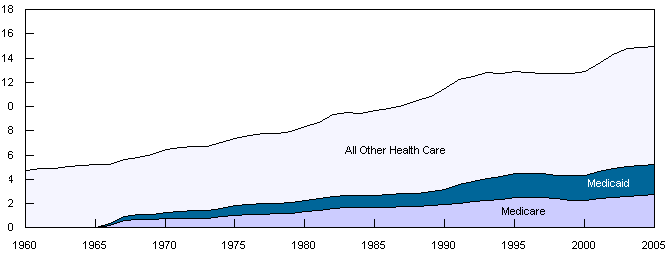Background
Medicaid is the United States' health program for qualified individuals and families with low incomes and resources. It is a means-tested program that is jointly funded by the states and federal government; however, it is managed by the states. Medicaid serves people who are U.S. citizens or legal permanent residents, including low-income adults, their children, and people with certain disabilities. Poverty alone does not necessarily qualify someone for Medicaid. Medicaid is the largest source of funding for medical and health-related services for people with limited incomes in the United States.
Medicare is a national social insurance program, administered by the U.S. federal government since 1965. It guarantees access to health insurance for Americans ages 65 and older in addition to younger people with disabilities and people with advanced renal disease. Medicare has a different social role from for-profit private insurers, which manage their risk portfolio to maximize profitability by denying coverage to those they anticipate will need it. As a social insurance program, Medicare spreads the financial risk associated with illness across society in order to protect everyone. In 2008, the U.S. Federal Government spent $391,266,000,000 on Medicare.
Features
Beginning in the 1990's, many states received waivers from the federal government to create Medicaid managed care programs. Under managed care, Medicaid recipients are enrolled in a private health plan, which receives a fixed monthly premium from the state. The health plan is then responsible for providing for all or most of the recipient's healthcare needs. Today, all but a few states use managed care to provide coverage to a significant proportion of Medicaid enrollees. Nationwide, roughly 60% of enrollees are enrolled in managed care plans. Core eligibility groups of poor children and parents are most likely to be enrolled in managed care, while the elderly and disabled eligibility groups more often remain in traditional "fee for service" Medicaid.
Some states operate a program known as the Health Insurance Premium Payment Program (HIPP). This program allows a Medicaid recipient to have private health insurance paid for by Medicaid. As of 2008, only a few states had premium assistance programs and enrollment was relatively low. However, interest in this approach remained high.
Medicare Advantage plans are required to offer coverage that meets or exceeds the standards set by the original Medicare program, but they do not have to cover every benefit in the same way. If a plan chooses to pay less than Medicare for some benefits, like skilled nursing facility care, the savings may be passed along to consumers by offering lower co-payments for doctor visits. Medicare Advantage plans use a portion of the payments they receive from the government for each enrollee to offer supplemental benefits. All plans limit their members' annual out-of-pocket spending on medical care, with a yearly limit of $6,700. Some plans offer dental coverage, vision coverage, and other services not covered by Medicare Parts A or B. These plans are a good value for the health care dollar, if an individual wants to use the provider included in the plan's network.
Comparing Medicare and Medicaid
Unlike Medicare, which is solely a federal program, Medicaid is a joint federal-state program. Each state operates its own Medicaid system, but this system must conform to federal guidelines in order for the state to receive matching funds and grants. The matching rate provided to states is determined using a federal matching formula (called Federal Medical Assistance Percentages), which generates payment rates that vary from state to state, depending on each state's respective per capita income. The wealthiest states only receive a federal match of 50% while poorer states receive a larger match.
Medicaid funding has become a major budgetary issue for many states over the last few years. On average, states spend 16.8% of their general funds on the program. If the federal match expenditure is also counted, the program usually takes up 22% of each state's budget.

U.S. Healthcare GDP
Spending on U.S. healthcare as a percentage of gross domestic product (GDP).
Medicare is a earned entitlement. Entitlement is most commonly based on a record of contributions to the Medicare fund. As a result, it is a form of social insurance that makes it feasible for people to pay for insurance for sickness in old age. They contribute to the fund when they are young and able to work. Medicare offers assurance that contributing individuals will receive benefits when they are older and no longer working. Some people will pay in more than they receive back and others will get back more than they paid in, but this is the practice with any form of insurance, public or private.